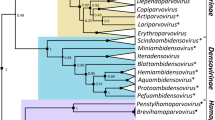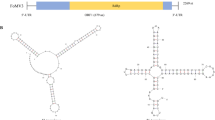Abstract
Ixeris denticulata is a perennial herbal plant with important medical and economic value. In this study, a novel rhabdovirus from I. denticulata with leaf curling and mottle symptoms was identified through next-generation sequencing and molecular cloning approaches. Based on the host species and properties of this virus, it was tentatively named "Ixeris denticulata-associated rhabdovirus" (IdaRV). IdaRV has a negative-sense RNA genome that is 12,705 nucleotides in length and has five open reading frames (ORFs) in the order 3’-nucleoprotein -phosphoprotein -movement protein -matrix protein -large RNA-dependent RNA polymerase-5’. Pairwise sequence comparisons showed that IdaRV had 42.2–53.0% sequence identity to members of the genera Cytorhabdovirus, Varicosavirus, Betanucleorhabdovirus, Gammanucleorhabdovirus, Dichorhavirus, and Alphanucleorhabdovirus in the subfamily Betarhabdovirinae. BLASTp searches indicated that putative products of ORF1, ORF2, ORF3, ORF4, and ORF5 of IdaRV are most closely related to those of rudbeckia virus 1 (RudV1, GenBank accession number ON185810), with 32.1%, 21.3%, 52.4%, 37.6%, and 57.1% amino acid sequence identity, respectively, at the protein level. Phylogenetic analysis showed that IdaRV forms a smaller branch with RudV1, which belongs to the genus Cytorhabdovirus. These results establish IdaRV as a novel rhabdovirus in the genus Cytorhabdovirus of the family Rhabdoviridae.


Similar content being viewed by others
References
Mann KS, Dietzgen RG (2014) Plant rhabdoviruses: new insights and research needs in the interplay of negative-strand RNA viruses with plant and insect hosts. Arch Virol 159(8):1889–1900. https://doi.org/10.1007/s00705-014-2029-z
Walker PJ, Freitas-Astúa J, Bejerman N et al (2022) ICTV virus taxonomy profile: Rhabdoviridae 2022. J Gen Virol 103(6):001689. https://doi.org/10.1099/jgv.0.001689
Jackson AO, Dietzgen RG, Goodin MM et al (2005) Biology of plant rhabdoviruses. Annu Rev Phytopathol 43:623–660. https://doi.org/10.1146/annurev.phyto.43.011205.141136
Whitfield AE, Huot OB, Martin KM et al (2018) Plant rhabdoviruses-their origins and vector interactions. Curr Opin Virol 33:198–207. https://doi.org/10.1016/j.coviro.2018.11.002
Walker PJ, Dietzgen RG, Joubert DA et al (2011) Rhabdovirus accessory genes. Virus Res 162(1–2):110–125. https://doi.org/10.1016/j.virusres.2011.09.004
Dietzgen RG, Bejerman NE, Goodin MM et al (2020) Diversity and epidemiology of plant rhabdoviruses. Virus Res 281:197942. https://doi.org/10.1016/j.virusres.2020.197942
Villamor DEV, Ho T, Al Rwahnih M et al (2019) High throughput sequencing for plant virus detection and discovery. Phytopathology 109(5):716–725. https://doi.org/10.1094/PHYTO-07-18-0257-RVW
Wang Y, Song Y, Wang Y et al (2020) Discovery and characterization of a novel ampelovirus on firespike. Viruses 12(12):1452. https://doi.org/10.3390/v12121452
Bejerman N, Dietzgen RG, Debat H (2021) Illuminating the plant rhabdovirus landscape through metatranscriptomics data. Viruses 13(7):1304. https://doi.org/10.3390/v13071304
Zhang S, Huang A, Zhou X et al (2021) Natural defect of a plant rhabdovirus glycoprotein gene: a case study of virus-plant coevolution. Phytopathology 111(1):227–236. https://doi.org/10.1094/PHYTO-05-20-0191-FI
Lee DS, Kim J, Jun M et al (2022) Complete genome sequence of a putative novel cytorhabdovirus isolated from Rudbeckia sp. Arch Virol 167(11):2381–2385. https://doi.org/10.1007/s00705-022-05556-x
Gaafar YZA, Richert-Pöggeler KR, Maaß C et al (2019) Characterisation of a novel nucleorhabdovirus infecting alfalfa (Medicago sativa). Virol J 16(1):55. https://doi.org/10.1186/s12985-019-1147-3
Heim F, Lot H, Delecolle B et al (2008) Complete nucleotide sequence of a putative new cytorhabdovirus infecting lettuce. Arch Virol 153(1):81–92. https://doi.org/10.1007/s00705-007-1071-5
Tamura K, Stecher G, Kumar S (2021) MEGA11: molecular evolutionary genetics analysis version 11. Mol Biol Evol 38(7):3022–3027. https://doi.org/10.1093/molbev/msab120
Lu J, Wu T, Zhang B et al (2021) Types of nuclear localization signals and mechanisms of protein import into the nucleus. Cell Commun Signal 19(1):60. https://doi.org/10.1186/s12964-021-00741-y
Petrzik K, Přibylová J, Špak J et al (2022) Mixed infection of blackcurrant with a novel cytorhabdovirus and black currant-associated nucleorhabdovirus. Viruses 14(11):2456. https://doi.org/10.3390/v14112456
Acknowledgement
This work was supported by grants from the National Natural Science Foundation of China (nos. 32372480 and 31930092), the Industrial Innovation Institute Project of Longquan, China (no. 109205-Y11902), and the Yunnan Zhou Xueping Expert Workstation (no. 202205AF150047).
Author information
Authors and Affiliations
Contributions
Xueping Zhou and Zhanqi Wang contributed to the study conception and design. Yaqin Wang and Yongzhi Wang performed the sample collection and data analysis. Qinwen Zeng and Qiqiang Xu prepared the figures and tables. Yaqin Wang and Zhanqi Wang wrote the manuscript. Zhenghe Li and Xueping Zhou revised the manuscript. All authors read and approved the final manuscript.
Corresponding authors
Ethics declarations
Ethical approval
This article does not contain any studies with human participants or animals performed by any of the authors.
Conflict of interest
All authors declare they have no conflict of interest.
Additional information
Communicated by Jesús Navas-Castillo
Publisher’s Note
Springer Nature remains neutral with regard to jurisdictional claims in published maps and institutional affiliations.
Electronic Supplementary Material
Below is the link to the electronic supplementary material
Rights and permissions
Springer Nature or its licensor (e.g. a society or other partner) holds exclusive rights to this article under a publishing agreement with the author(s) or other rightsholder(s); author self-archiving of the accepted manuscript version of this article is solely governed by the terms of such publishing agreement and applicable law.
About this article
Cite this article
Wang, Y., Wang, Y., Li, Z. et al. Genomic characterization of a novel cytorhabdovirus infecting Ixeris denticulata in China. Arch Virol 169, 46 (2024). https://doi.org/10.1007/s00705-024-05988-7
Received:
Accepted:
Published:
DOI: https://doi.org/10.1007/s00705-024-05988-7




